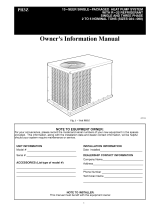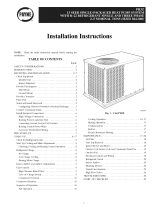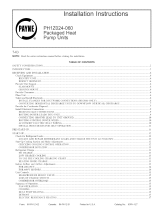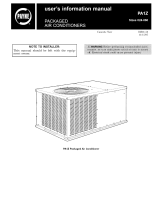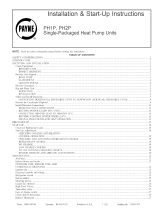Page is loading ...

Owner's Guide
A Guide to Operating and
Maintaining Your Heat Pump
Single-Package Heat Pump Unit
PH3Z
Fig, 1--Unit PH3Z
N(-)TE TO INSTALLER: This manual should be lefl with the equipn_ent owner.
FOR YOUR SAFETY
Do not slore or use gasoline or other flamnmble vapors and liquids in the vicinity of this or any other appliance.
/_ WARNING: FIRE, EXPLOSION, ELECTRICAL SHOCK HAZARD
Failure to follow this warning could result in personal injury, death or property damage.
Do not use this unit if any part has been under water. Immediately call a qualified service technician to inspect the unit and
to replace any part of the control system which has been under water.
Z_ WARNING: ELECTRICAL SHOCK HAZARD
Failure to follow this warning could result in personal injury, death.
Before performing recommended maintenance, be sure the main power switch to unit is turned off.
WELCOME TO EFFiCiENT YEAR=ROUND COMFORT
Congratulations on your excellent choice and sound investment in year-reund home colnlk)rt!
Your new heat pump represents both the latest in engineering development and the cuhnination of many years of experience l?'om one of the most
reputable manufacturers of comlk_rt systems.
Your new unit is among the most energy-efficient and reliable heat pump products available today. To assure its dependability, spend just a few
minutes with this booklet now to learn about the operation of your heat pump, and the small amount ef maintenance it takes to keep it operating
at its peak el]]ciency. With minimal care, your new heat pump will provide you and your family with year-round home comli_rt both now and
liar years to come.
SAFETY CONSIDERATIONS
Recognize salk:ty inlk)rmation. This is the salk_ty-alert symbolz_ x . When you see this symbol on unit or in instructions and manuals, be alert to
potential lot personal injury.
Catalog No. OG-PH3Z-01 Cancels: New Printed in U.S.A. 9-05

Understand the signal words DANGER, WARNING, and CAUTION. These words arc used with the salety-alert symbol. DANGER identifies the
most serious hazards which will result in severe personal injury or death. WARNING signifies hazards which could result in personal injury or
death. CAUTION is used to identify uusale practices which may result in minor personal in,jury or product and property damage. NOTE is used
to highlight suggestions which will result in enhanced installation, reliability, or operation.
AWARNING: FiRE AND ELECTRICAL SHOCK HAZARD
Improper installation, adjustment, alteration, service, maintenance, or use can cause explosion, fire, electrical shock, or
other conditions which could cause serious injury, death or property damage. Consult aqualified installer, service agency,
or your distributor or dealer for information or assistance. The qualified installer or agency must use factory-authorized kits
or accessories when modifying this product.
YOUR COMFORT SYSTEM
A. identifying Your System
Take the time to l_uTlilial'ize yourself with your packaged heat pump type of system. This knowledge will be of use in understanding the basic
operation of your new heat pump. The unit has a rating plate alTixed to it which provides necessary iulk_rmation lk)rspecific identification of a unit.
You should familiarize yourself with the product, model, and serial numbers listed on each rating plate. Record them lor luture relerence in the
space provided at the end of this booklet.
iMPORTANT FACTS
To better protect your investment and to diminate unnecessary calls, fan-liliarize yourself with tile lk_llowing lhcts:
1. Your heat pump system should never be operated without a clean air filter properly installed. Phm to inspect the filter periodically. A
clogged air filter will increase operating costs and shorten the liB: of the unit.
2. Supply-air and return-air registers should not be blocked. Drapes, furniture, and toys are some ol' the items conlmonly limnd obstructing
registers. Restricted airflow lessens the unit's efficiency and lile span.
3. The outdoor unit must have unrestricted airflow. Do not cover the unit, lean anything against it, or stand on it. Do not allow grass clippings,
leaves, or other debris to accumulate around on top of the unit. Maintain a 30-in. uliniumm clearance between the outdoor unit and tall grass,
vines, shrubs, etc.
4. Your multipurpose indoor thermostat is the control center lk_ryour heat pump system. You should l'amiliarize yourself with its proper
operation. Attempting to control the system by other means lk_rinstance, switching the electrical supply power ON and OF_may cause
damage to the unit (See Fig. 3).
5. During heating, increasing the thermostat setting more than 2 degrees may cause the supplemental heaters to be turned on lk_ra short period
ol' time to satisfy the thermostat. Needless use of the supplementary heat reduces potential energy savings.
6. You may find that you can maintain greater personal comlk_rt by running the fan continuously. "Air pockets" can form due to the structure
of the house, placement of registers, etc. air pockets may be too cool or warm liar your liking. Continuous fan operation miuinlizes any
temperature dillerences. Also, systems equipped with electronic or mechanical air cleaners and/or humidifiers ollk:r the added benefits ol'
having the air continuously cleaned year-round aud humidified during the winter season.
7. Your heat pump will remove humidity from your home during the cooling season. Alter a lk_wminutes of operation, you should be able
to see water trickle from the condensate drain. Check this occasionally to be sure the drain system is not clogged. Of course, don't expect
to see much drainage if you live in a very dry environment.
8. During the heating cycle, air from your registers may seem cooler than you might first expect. This is because your heat pump delivers a
constant flow of air at around 9(YF to 105°F instead of sudden bursts of hot air as with a conventional furnace. This air may lk:el cooler
because it is slightly less than your skin temperature. However, it is sufl'icieutly warm to keep you comlk_rtable.
9. Ice or fi'ostwill tend to lk)rmon the coil during the winter heating operation. Your heat pump is designed to automatically melt the ice. When
in this defrost cycle, it is llormal li)r steam or li)g to rise from the outdoor unit. Do not be alarmed!
10. Do not operate your unit in cooling mode when outdoor temperatures are below 55"F unless your unit was modified li)r low-ambient
operation.
11. Do not operate your unit in heating mode when outdoor temperatures are above 66°F unless you set your thermostat to emergency heat
mode.
Z_x WARNING: FiRE AND ELECTRICAL HAZARD
Failure to follow this warning could result in personal injury, death and/or property damage.
To prevent serious injury, death, or property damage, read and follow all instructions and warnings, including labels shipped
with or attached to unit before operating your new heat pump.
OPERATING YOUR HEAT PUMP
Tile operation of your heat pun-lp system is controlled by the indoor thernlostat. You simply ad,just the thermostat and it maintains the indoor
temperature at the level you select. Most thermostats lk_rheat pump systems have 3 controls: a temperature control selector, a FAN control, and
a SYSTEM or MODE controh
B. Cooling Mode
When operating in cooling mode, your heat pump will run ill cooling mode until the indoor temperature is lowered to tile level you have selected.
On extremely hot days, your heat pump will run lk_rlonger periods at a time and have shorter "o1"1"periods than on moderate days.
2

v._
"ID ] °
IC J
®
CK)
CEF
Fig. 2--Payne Non-Programmable Thermostat
I N I
MAIN i
Fig. 3--Main Electrical Disconnect A92135
Tile I_)llowing are typical conditions that add extra heat and/or humidity to your borne. Your heat pump will work longer to keep your borne
coml_)rtable under these conditions:
l. Entrance doors are frequently opened and closed
2. Laundry appliances are being operated
3. A shower is running
4. Mow than the usual number of people are present in the home
5. More than the normal number of electric lights are in use
6. Drapes are open on the stmny side of the home
C. Heating Mode
With the SYSTEM or MODE control of your indoor thermostat set to HEAT, your heat pump will run in beating mode until roon] temperature
is raised to the level you have selected. Of course, your heat pnmp will have to operate lk_rlonger periods to maintain a colnlk_rtable environment
on cooler days and nights than on moderate ones.
D. Defrost Mode
When your heat primp is providing heat to your home and the outdoor temperature drops below 45°F, moisture may begin to fl'eeze on the surface
of the coil. If allowed to build tap,this ice would impede airflow across the coil and reduce the amount of heat absorbed from the outside air. So,
to maintain energy-efHeient operation, your heat pump has an automatic defrost mode. The defl'ost mode starts at a preset time interval of 60
minutes. Del)'ost will start at the preset time only if the ice is sul]_cient to interlere with normal beating operation. Alter the ice is melted l)'om
the coil, or after a nmxinmm of 10 minutes in dei)'ost mode, the unit automatically switches back to normal beating operation.
Do not be alarmed if steam or l_)g appears at the outdoor unit during del)'ost mode. Water vapor from the melting ice may condense into a mist
in the cold outside air. During certain weather conditions such as heavy snow and l)'eezing rain it is not uncommon lot ice to build up on the unit
grille. This is normal Rn"these weather conditions. Do not attempt to remove the ice l)'om the unit grille. This eonclition will not aflcct the proper
limction of the unit and will clear a lew days.
E. Emergency Heat Mode
This allows your supplemental beating source to keep your home or oflice warm until your heat pmnp can be serviced. Also, if the electricity to
your beat pump has been o11"lor more than 30 minutes, switch your themaostat to EHEAT mode bel_re restarting your heat pump. Leave the system
in EHEAT mode lor an amount of time equal to the power outage. It is not necessary to exceed 12 hrs. (If you cannot determine bow long the
power has been olT, leave the system in EHEAT mode I_)r8 hrs.)
PERFORMING ROUTINE MAINTENANCE
With the proper maintenance and care, your heat pump will operate economically and dependably. Maintenance can be accomplished easily by
rcli_rring to the liHlowing directions. However, beli_re perlbrming maintenance, consider these important sali_ty precautions:
Z_ WARNING: ELECTRICAL SHOCK HAZARD
Failure to follow this warning could result in personal injury and/or death.
Disconnect all electrical power to the indoor air handier or furnace before removing access panels to perform any
maintenance. Disconnect power to both the indoor and outdoor units. Note: There may be more than 1 electrical disconnect
switch.
Z_X CAUTION: PERSONAL INJURY HAZARD
Failure to follow this caution may result in personal injury.
Although special care has been taken to minimize sharp edges in the construction of your unit, to avoid injury be extremely
careful when handling parts or reaching into the unit.
3

F. ChecktheAirFilter
A dirty air filter will cause excessive strain on the compressor and blower motor. This can cause the components to overheat and autonmtically
shut down. In the worst case, the components will fail and need to be replaced. To avoid inefficient or failed operation of your unit, CHECK THE
FILTER(S) EVERY 3 MONTHS. Replace filter(s) when necessary, or clean the filter(s) if you have the reusable type.
Disposable filters should be replaced by similar, new filters of the same dimensions.
Reusable, pernlanent filters should be washed in a solution of cold water and mild detergent, then rinsed and thoroughly dried. THE FILTER
MUST BE COMPLETELY DRY BEFORE BEING REINSTALLED. To avoid prolonged shutdown of your unit while a filter is drying, you
should have an extra filter on hand. This allows you to rotate between the two with minimal downtime %r your com%rt system. Extra filters may
be purchased /born your dealer.
The filters(s) and filter rack lk_ra packaged system are supplied and installed by the contractor or dealer. Typically, the filter(s) and rack are located
in the return-air duct at the outdoor unit or behind the return-air grille(s). Have your dealer show you the location of your filter(s) and the
procedures lk_rremoval and replacement.
If your system includes a high efficiency or electronic air cleaner, relL'r to air cleaner User's Manual lk)r proper filter cleaning or replacement.
G, Outdoor Coil
If grass clippings, leaves, shrubbery, and debris are kept away fi'om the unit, minimal care should be sufficient to keep the system lunctioning
properly. However, if the outdoor coil becomes dirty, use a vacuum cleaner or shop vac with soft brush attachment to clean the exterior surface.
Vacuum coil surface using an up and down motion. Be careful not to bend or damage fins.
If dirt is deep in the coil, contact your dealer lot service. Do not attempt this yourself.
H, Outdoor Coil--Sea Coast
If yonr unit is located near the ocean, special maintenance is required. Ocean mist/breeze carries salt, which is corrosive to most metals. Although
your new unit is made out of galvanized metal and is protected by top-grade paint, you should take the precaution of additional maintenance which
consists of periodically washing the unit. By washing all exposed surfaces and coil you will be adding additional lilt to your unit. Please consult
your installing contractor lot proper intervals/procedures %r your geographic area or service contact.
I. UNIT SUPPORT
Your packaged heat punlp unit shouhl be mailltailled at a level position. If its support should shil_ or settle so thai tile unit is uo longer level, you
should correct the condition. Relevel it promptly to assure water drains out of the unit. If you notice that water or ice collects beneath the unit,
arrange lot it to be drained away l)'om the unit.
BEFORE YOU REQUEST A "SERVICE CALL"
CHECK FOR THESE EASILY SOLVED PROBLEMS:
1. ('heck the indoor and outdoor disconnect switches. Verily,, that circuit breakers are ON or that fuses have not blown.
2. Check %r sufficient airflow. Check the air filter(s) %r any accumulations of dirt. Check %r blocked return-air or supply-air registers. Be
sure registers are open and unobstructed.
3. Check the settings on your indoor thermostat. If you desire cooling, make sure that the temperature control selector is set below room
temperature and the SYSTEM or MODE control is set to COOL or AUTO. If you require warmth, make sure that the temperature control
selector is set above room temperature and the SYSTEM or MODE control is set to HEAT or AUTO. The FAN control should be set to
ON lor continuous blower operation or AUTO if you wish blower to function only while your heat pump is operating. If your comlk_rt
system still fails to operate, turn your system off and contact your servicing dealer lor troubleshooting and repairs. Specify your apparent
problem, and state the model and serial nmnber of your equipment. (You should have them recorded on the last page of this booklet.) With
this inlormation, your dealer may be able to oflk_rhelpful suggestions over the phone or save valuable time through knowledgeable
preparation lk)r the service call.
REGULAR DEALER MAINTENANCE
Ill addition to tile routine maintenance thai you pel'12mn, your home con-dkn'tsystem should be inspected regularly by a properly trained service
technician. The inspection (prelk:rably twice each year, but a1 least once every year) should include the lollowing:
1. Routine inspection of air filter(s). Replacement or cleaning as required.
2. Inspection and cleaning of the blower wheel, housing, and motor as required.
3. Inspection and, if required, cleaning of coils.
4. A check of all electrical wiring and connections.
5. A check lot secure physical connections of individual components within unit.
6. OperaIional check of the heat pump system to determine actual working condition. Necessary repair and/or adjusmlent should be perlormed
at this time.
7. Your servicing dealer may ol)k_ran economical service contract thai covers seasonal inspections. Ask lot l_mher details.
WARRANTIES
You have purchased a PH3Z series unit. Be sure to read the warranty at tile back of this booklet carelully to determine tile coverage %r your unit.
FOR THE RECORD
Record the n-lodel, product, and serial nun-lbers of your new equipment in the spaces provided. This inlormatiou, along with the other
ready-relk:rence facts requested will be necessary should you ever require inlormation or service.

Date Installed
Dealer's Name
Address
City
State/Zip
Telephone
Unit Model
Unit Serial Number
Heater, if applicable:
Part Number
Kilowatt Rating
INSTALLATION DATA
UNIT DATA
5

6

7

© 2005 Payne Heating & Cooling 7310 W. Morris St., Indianapolis, IN 46231 S Catalog No. OG-PH3Z-01
/
